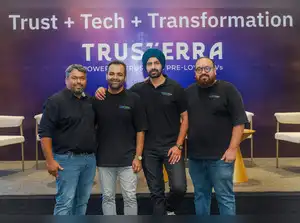
In a significant boost for India’s agritech and deep-tech ecosystem, TrusTerra, an innovative agricultural supply chain startup, has raised ₹9 crore in a pre-seed funding round. The investment will accelerate the development of its blockchain-powered platform designed to bring transparency, traceability, and fairness to India’s farming sector.
This funding underscores growing investor interest in startups that leverage technology to solve systemic challenges in agriculture—a critical sector contributing significantly to India’s economy and employment.
The Mission: Solving Agriculture’s Trust Deficit
TrusTerra aims to address long-standing issues in agricultural supply chains, including:
- Lack of Transparency: Farmers and consumers often remain unaware of the origin, quality, and journey of produce.
- Middlemen Dependency: Intermediaries fragment the supply chain, reducing farmers’ profit margins.
- Food Safety Concerns: Difficulty in tracing contaminated or low-quality products back to their source.
By integrating blockchain, IoT, and AI, TrusTerra creates an immutable record of every transaction and movement—from farm to fork.
How TrusTerra’s Platform Works
1. Farm-Level Data Capture
- Farmers log details like crop type, sowing date, and input usage (fertilizers, pesticides) via a mobile app.
- IoT sensors monitor soil health, weather conditions, and crop growth.
2. Blockchain-Based Traceability
- Each batch of produce is assigned a unique QR code.
- Every change of hands (farmer → collector → processor → retailer) is recorded on the blockchain.
3. Consumer-Facing Verification
- End-users scan the QR code on products to access:
- Farm origin and farmer details
- Certifications (organic, fair trade, etc.)
- Travel history and storage conditions
Why This Funding Matters
The ₹9 crore pre-seed round will enable TrusTerra to:
- Scale Technology Infrastructure: Enhance its blockchain and IoT capabilities.
- Onboard Partner Farms: Expand operations across key agricultural states like Maharashtra, Punjab, and Karnataka.
- Build Industry Partnerships: Collaborate with food processors, retailers, and export agencies.
- Obtain Certifications: Align with global standards for organic and sustainable farming.
Market Opportunity: The Rise of Conscious Consumers
TrusTerra is tapping into powerful trends shaping the future of food:
- Demand for Transparency: 73% of consumers are willing to pay more for brands that offer supply chain transparency (Source: IBM).
- Growth of Organic & Premium Foods: The Indian organic food market is projected to reach ₹75,000 crore by 2025.
- Government Initiatives: Schemes like PM-KISAN and Digital Agriculture Mission prioritize technology adoption in farming.
Differentiators and Competitive Edge
TrusTerra stands out through:
- Farmer-Centric Design: The platform is built for low digital literacy, using voice commands and vernacular support.
- Interoperability: It integrates with existing government databases (e.g., e-NAM, soil health cards).
- Sustainability Focus: Promotes climate-resilient farming by tracking water usage, carbon footprint, and soil health.
Challenges and the Road Ahead
TrusTerra will need to navigate:
- Farmer Adoption: Building trust among smallholder farmers accustomed to traditional practices.
- Infrastructure Gaps: Limited internet connectivity in rural areas may hinder real-time data capture.
- Competition: Established players like Ninjacart and DeHaat are also investing in traceability features.
The Bigger Picture: Aligning with National Goals
TrusTerra’s mission aligns perfectly with India’s broader ambitions:
- Atmanirbhar Bharat: Strengthening agricultural self-reliance through technology.
- Digital India: Bridging the urban-rural digital divide.
- Sustainable Agriculture: Supporting India’s COP26 commitments to climate-resilient farming.
Conclusion: Sowing the Seeds of Change
TrusTerra’s ₹9 crore pre-seed funding marks the beginning of a transformative journey to reimagine India’s agricultural supply chains. By harnessing blockchain and IoT, the startup is not only empowering farmers with better prices and visibility but also enabling consumers to make informed, ethical choices.